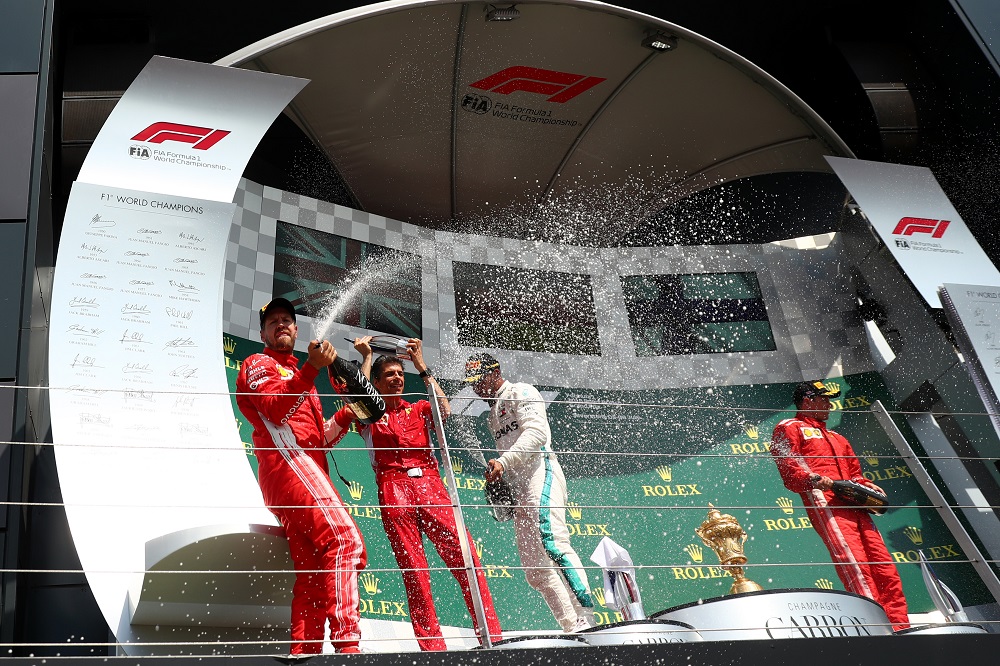Despite the uncertainty surrounding the future of the British Grand Prix at Silverstone, there is no denying the power that Formula One possesses as a platform for brands to tap into. That being said, at Sports Marketing Surveys we took a closer look at last weekend’s British Grand Prix, using human intelligence and social insights tool, SMS INC RADAR, to see how well it was received and what the brands were up to.
From our analysis, whiskey giant, Johnnie Walker were arguably the most dominant force from a brand perspective, setting out its stall through its #JoinThePact initiative. Specifically, its #JoinThePact giant billboard at the event appeared to captivate fans, mentioned in 44 per cent of commentary surrounding the initiative.
Interestingly, very few of these posts referenced Johnnie Walker, but as a long-term initiative that 8.5 million people have bought into pledging to never drink and drive, I’d argue by not requiring pledgers to mention Johnnie Walker it has been a far more credible corporate social responsibility exercise.
Good corporate social responsibility campaigns like Johnnie Walker’s put the social issue at the forefront of the campaign and the brand messaging second. By doing this, Johnnie Walker has cleverly united a huge group of people to a common goal and will benefit by association. This is something that was reflected in our analysis of this weekend’s race, with 100 per cent of the commentary surrounding the initiative positive.

Valtteri Bottas driving the Mercedes AMG Petronas F1 Team Mercedes leads Sebastian Vettel of Germany on track during the the F1 Grand Prix of Britain
Aside from Johnnie Walker, Heineken was another brand that chose to go down the corporate social responsibility route with its marketing strategy surrounding this year’s Grand Prix. The brand made good use of its ambassador Nico Rosberg, to again convey a simple message to viewers never to drink and drive through a creative advert.
This campaign triggered more varied responses, with 20 per cent of the commentary branding it ‘awkward’. In Heineken’s primary capacity to deliver a message, however, I would argue it was executed well. This was backed up by the commentary online which was 78 per cent positive.
The one key difference that stood out between the two brand activities was around engagement, and as a result I believe Johnnie Walker was the clear winner. By focusing on consumer engagement rather than purely a simple message, the brand was able to effectively create a social media conversation and gain genuine buy-in from fans and consumers. It mobilised a group of 8.5 million users, and ultimately shows the power of engagement in the 21st century.
By virtue of its position as the title sponsor of the event, Rolex also benefitted from a significant proportion of mentions online. That being said, however, this was largely generic chatter and I would have liked to have seen Rolex do more to engage its audience.
I would be hesitant to say that the event wasn’t a success for them as there’s no doubt Rolex’s presence was felt throughout, but I think the challenge for a lot of brands now is to engage with its audiences, creating brand advocacy whether that be through social conversation, event activations or the wider marketing mix.
As an organisation, Formula One is at the forefront of the technology curve providing new and innovative ways for fans to immerse themselves in the series’ brand. Its over-the-top (OTT) network, the launch of the Formula One esports series and its work with augmented reality (AR) and virtual reality (VR), are a few examples of some of Formula One’s successes. I’d like to see brands tap into this wealth of opportunity to greater effect as these are areas we have found to generate positive engagement in the past.
From a more general perspective, I suspect brands will be hoping Silverstone remains a regular fixture on the Formula One calendar as 350,000 spectators attended the race weekend. The data certainly reflected this, with 89 per cent of individuals online expressing positive sentiment towards the event. Among these individuals, 58 per cent also went one step further to share thank you notes to Silverstone and the staff, commenting on how it was an amazing event to watch.
With this positivity at its core, I side with the opinion that Silverstone should remain as a mainstay on the series’ calendar – 22 per cent of individuals already wanted to know when pre-sale would begin for next year, which shows the appetite is still there from a consumer perspective.

As Director of SPORTS MARKETING SURVEYS INC, Richard Payne oversees all commercial and new-business activity for the agency.
Since 2008, Payne has managed the company’s global research projects working with The Wimbledon Championships, The R&A, European Tour and with major sports equipment brands including Nike and Adidas.
Analysis and insight provided by SMS INC. RADAR – SMS INC. RADAR is a human intelligence and social insights tool produced by SPORTS MARKETING SURVEYS INC., the UK research company with more than 30 years’ experience in sports data analysis.

